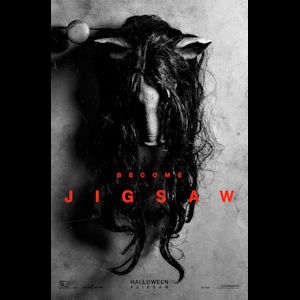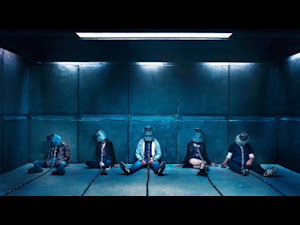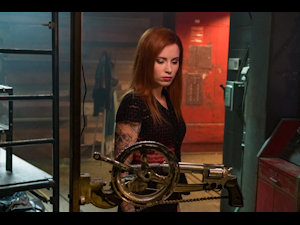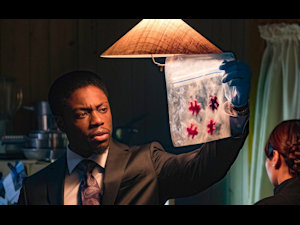Jigsaw - Movie Review
 | | Jigsaw |
Five strangers wake up in a sparse room, bound with chains around their necks and metal buckets on their heads, as an ominous voice tells them it's time to play a game. Elsewhere, two morgue technicians and two police officers examine a body with a telltale puzzle-piece-shaped wound carved out of its neck and a recording embedded within, announcing the return of a serial killer who's supposedly been dead for ten years. This is how Jigsaw begins, the eighth entry in a horror franchise that has been dormant since 2010. Reportedly, the producers behind the series waited for the right pitch to come across their desks before relaunching it, and they rejected several ideas over the years. With plenty of fresh blood both behind and in front of the cameras, one would expect this new entry to be something a bit different, but truth be told, it's a surprisingly by-the-numbers Saw flick, both for better and for worse.
Granted, the underlying mysteries--of how Jigsaw is continuing to operate after so many years, why he's been quiet for so long, and what shenanigans are going to be revealed by the inevitable series of twists in the third act--hold the film together through its predictably half-baked police procedural bits, and both the acting and effects work are generally an improvement over the last two or three films in the series. On top of that, the sadistic Jigsaw traps (which, let's face it, are why most people go to these movies) are less ridiculously complex and more back-to-basics horrifying, while the story continues the franchise's tradition of honoring and reflecting on the previous ones, with plenty of nods, easter eggs, and blatant references to events the hardcore fans should remember well.
 | | It's Plankton, isn't it? |
However, it all comes off as a bit thin and unremarkable. This isn't the revitalization one might expect, and it's definitely not a reboot or a decent entry point for newcomers. It feels like it could have easily come out in 2011, one year after the predictably misnamed Saw: The Final Chapter. Fans will like it, and compared to some of its weaker brethren, Jigsaw is perfectly fine for what it is. It might even breathe enough life into the franchise to allow for more movies in the future, but if you're hoping to see the formula shaken up a bit or to see something new brought into the mix, you'll be disappointed (unless you've been waiting to see Jigsaw use lasers).
Don't get me wrong: as a fan of this kind of popcorn entertainment, I enjoyed Jigsaw. I would go so far as to hope the series continues. But from a purely critical standpoint, it's hard to find anything here that separates it from all the movies that came before. It is unfortunate that seven years haven't given the filmmakers more room to be daring, different, or truly surprising. Then again, maybe there's something to be said for the old adage about things that aren't broken.
 | | It's that thing from that other thing! |
One of the biggest positives is the acting. While I wouldn't call any of the performances groundbreaking or Oscar-worthy by any stretch, the character work is far better in Jigsaw than in the last few Saw flicks. From the victims to the police officers and techies, the acting is relatively solid. Callum Keith Rennie as Detective Halloran is especially notable for having believable moral ambiguity; Laura Vandervoort's Anna is one of the most memorable and interesting victims in the entire canon; and Clé Bennet's Detective Hunt is far more intriguing than you'd expect from his role as Halloran's glorified sidekick. The main character, Matt Passmore's Logan Nelson, is decent enough to carry the procedural half of the film, and his performance is nuanced enough to leave you guessing. Less successful is his lab tech partner, Eleanor (Hannah Emily Anderson), a wonky and weirdly written character who can't seem to act professional or hide her fangirl obsession with Jigsaw, but who doesn't seem concerned about police officers essentially telling her to her face that she's their prime suspect.
The plot knows that audiences are going to immediately start trying to figure out who among the four non-victim characters is secretly helping Jigsaw, and it acts accordingly, throwing up plenty of hints and misdirects throughout. In the end, all the clues add up to a logical conclusion I won't spoil, and though not one of the greatest twists in Saw history, it's satisfying enough. Given how long the series has been going, it does stretch credibility a bit, but not as much as, say, the big reveal at the end of Saw VI.
 | | The detective stuff is laughably bad |
Where credibility is totally lost, however, is in the actual police work. This is a new low in poor CSI mimickry, with DNA samples being processed in minutes, crime scenes inexplicably left unexplored, major details overlooked, people not sharing vital information, and technicians with superhumanly encyclopedic knowledge of obscure chemicals. Big, obvious pieces of the puzzle aren't put together by the detectives, not because they're hard to figure out, but only because the writers aren't ready to reveal things to the audience. The Saw movies have never been good at this kind of thing--not even the surprisingly well-made first entry--but the flaws are more obvious in Jigsaw than ever before.
In the end, Jigsaw is just fine. It lives up to its legacy, but it doesn't do anything more than that. It is a Saw movie, with all that entails, and though it is above average in some ways, it is plagued by its own flaws. The writers put all of their creativity into the traps themselves and the narrative contrivances that make it all work, but the formulaic structure of the series is utterly unchanged. Only time will tell if this entry is enough to keep Jigsaw alive going forward, but for audiences who love the Saw films, he's not dead yet.
FINAL SCORE:





While fans will undoubtably love seeing the franchise return, there's nothing that makes Jigsaw stand apart from all the other Saw sequels.
|
-e. magill 10/31/2017
|
|